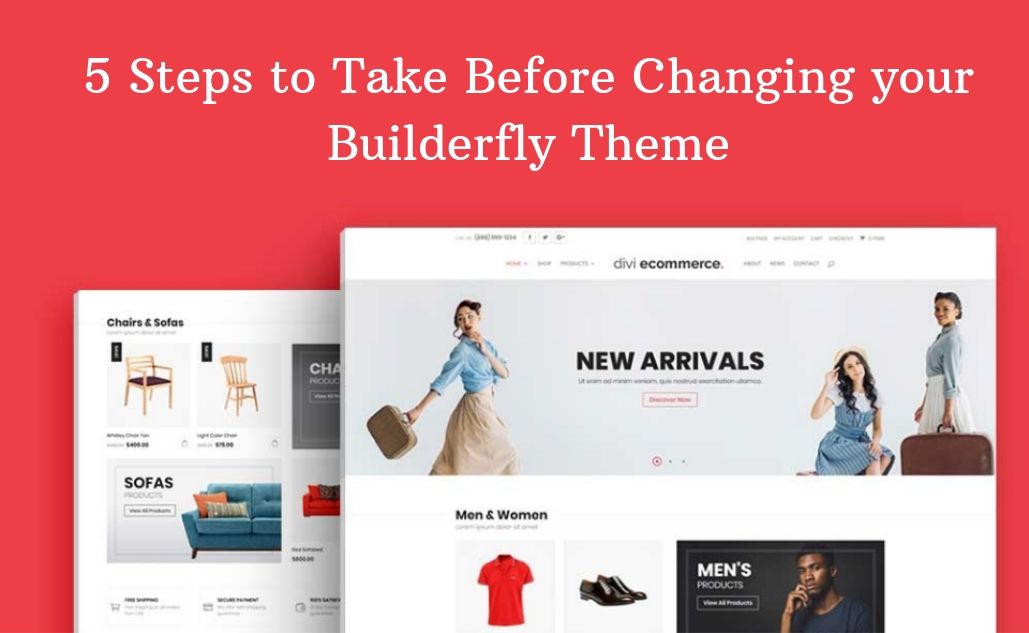A lot can change in a year or two, especially in a fast-paced, fast-growing industry like ecommerce. What seemed fresh and energizing a year ago—parallax, ghost buttons, hamburger menus,—is now unexceptional, even obsolete. In 2019, mobile is mandatory, storytelling is almighty, and if you aren’t making your store accessible to everybody, you’re falling behind.
For online sellers, the choice is clear: get left behind or keep up.
If you’ve been using the same theme for a year or more, you might be thinking about buying a new one. Maybe your current theme doesn’t support all the latest features. Perhaps you want more control over design and functionality. Or perhaps your business has evolved and your existing theme no longer reflects your brand. There can be many reasons for wanting to purchase a new theme.
The good news is that changing your Builderfly theme is a relatively straight-forward process. Before taking the plunge, read through these six steps to ensure a smooth transition.
Identify aspects of your existing theme you need to keep
When your store starts to feel stale and outdated, it can be tempting to tear the whole thing down and start from scratch. Resist.
Before doing anything rash, you ought to take a step back and jot down certain notes about your existing theme. What’s working? What needs to change? How has your business grown since you launched your store?
It’s important to keep a record of any edits you’ve made to your store’s template files. While you won’t lose your navigation, pages, blog posts, products, or collections by changing your theme, you will lose any revisions made to your Customize theme pages.
Merchants often make on-the-fly changes to these areas and neglect them. It’s a good idea to review your code and note all the additional snippets of code that have been added.
Conduct a competitive analysis
Whether you’re selling children’s clothing, juice cleanses, or auto parts, one of the best ways to get ahead and stay relevant is by keeping an eye on your contemporaries and competitors. How else are you going to keep on top of your industry’s hot new products, revolutionary marketing techniques, and winning social media strategies?
Though it’s always good practice to keep up with the Joneses—services like TrackMaven and Visual Ping will notify you when competitors update their sites—it’s especially important before changing your Builderfly theme. Look for things like how they’re displaying products, whether or not they’ve enabled ratings and reviews (if they are, read them!), which payment gateways they’re supporting, what type of navigation they’re using, and other product-specific details.
Make a list of everything your competitors are doing differently, and then ask yourself: how can I emulate what’s working?
Know what to look for in a theme
Since that you’ve done your research for your new theme, you’re ready to start browsing Builderfly themes.
Try not to get too caught up in aesthetics. As we’ve said before: function trumps fashion. Try not to be wooed by lovely typography and demo pictures you don’t own and can’t utilize.
Rather, stick to your list and try filtering for a portion of those ideal features. You can additionally sort by price or industry point. Builderfly has a rigorous submission process that ensures a high quality of design and functionality but, like everything, you tend to get what you pay for.
Make sure your chosen theme checks all your boxes, pay attention to the reputation of the developer and their customer support, and for the love of algorithms, make sure it’s responsive!
Prepare some new content and photography
A beautiful new theme can do so much for a store, yet it can’t do everything. Have you ever tried putting lipstick on a pig? You can’t simply splash a fresh coat of paint over your unwieldy navigation and dreary product images and expect a complete change. Even the best themes will look common without a decent base to work from.
Switching your Builderfly theme is the ideal time to put in professional, high-quality photography. Why? Because good photos increase conversion rates. Consumers want to be sure the product they’re looking at matches their expectations, and the bigger, clearer and more varied the images are, the better they’re able to do that.
Make some compelling, relevant content for your blog and landing page—and then let your theme work do something amazing.
Take a “before” snapshot
No, we don’t mean a screenshot for nostalgia’s sake. We mean a snapshot of your analytics so you can in the end thoroughly compare how your online store performed under two diverse theme designs.
Look at everything, but pay particular attention to the percentage of new visits versus returning visitors, average order value, bounce rate, page views per visit, landing and exit pages, and, of course, conversion rate and total revenue. You may additionally want to calculate a compound metric like revenue per unique session or visitor.
In a couple of months, take an “after” preview and see how far you’ve come. Hopefully, it’s a long way (baby)!








